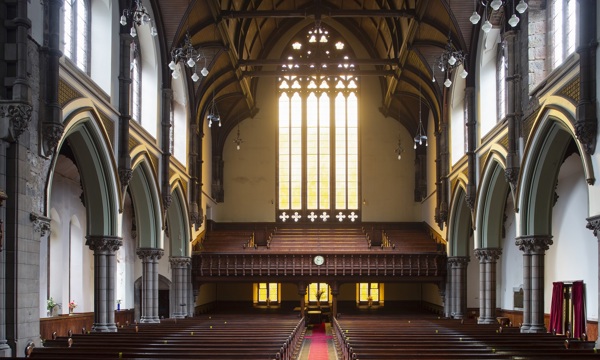St Columba’s Church on St Vincent Street has been granted A-listed status, Historic Environment Scotland (HES) announced today.
The category A listing recognises the quality and extent of its exterior and interior design which is largely unaltered as well as the building’s significant role in Gaelic-speaking worship in Scotland.
The church was previously listed at category B in 1970. Following a request to review the listing, HES researched the building and carried out a public consultation in March where members of the public were invited to express their views on the building being granted category A status.
St Columba’s Church, built between 1901-1904, is a notably large, complete and lavishly detailed later example of the Decorated Gothic style with high quality detail and craftmanship in its stone construction and interior features. Its largely complete interior retains much of its early 20th century character, including a bespoke pipe organ of national significance which is categorised as Grade I on the National Register of Pipe Organs.
The church is the largest and most ornate church outside of the Highlands built specifically for a Gaelic speaking congregation and was built following the demolition of the Hope Street Church of St Columba in 1900 to make way for an extension to Glasgow Railway Station. Hope Street Church was constructed in 1839 for the Gaelic speaking community following the mass migration of people from the Highlands and Islands to Glasgow in the first half of the 19th century. Compensation from the Caledonian Railway Company was used to construct the new church at 300 St Vincent Street.

A focal point for worship in the Gaelic language outside of the Highlands, St Columba’s Church was the only church in Glasgow to continue to hold a Gaelic language service on Sunday mornings from 2011 until 2020 when services in the church were suspended.
Decorative details within the church including an inscription 'Tigh Mo Chridhe, Tigh Mo Gràidh' (House of My Heart, House of My Love) by the poet Duncan Livingstone above the main entrance and a statue of St Columba reflect the church’s strong association with Gaelic worship, adding to the special design interest.
Dara Parsons, Head of Designations at HES, said: "St Columba’s Church has remained largely unaltered, retaining many of its interior and exterior details. While the Decorated Gothic style of St Columba’s was widely used in church design in Glasgow during the 19th century, the level of detail and wealth of carved stonework detailing that adorns St Columba’s both internally and externally is exceptional.
The outstanding design along with the church’s significant role within the Gaelic speaking community, adds to the building's special architectural and historic interest, and we are delighted to recognise its national importance with category A status."
Listing is the way that a building or structure of special architectural or historic interest is recognised by law through the Planning (Listed Buildings and Conservation Areas) (Scotland) Act 1997. The listed building record for St Columba’s Church can be found on our website.
View the listed building recordAbout Historic Environment Scotland (HES)
- We are the lead public body charged with caring for, protecting and promoting the historic environment. We will lead on delivering Scotland’s first strategy for the historic environment, Our Place in Time.
- Historic Scotland, Scran, Canmore, The National Collection of Aerial Photography (NCAP), The Engine Shed, Stirling Castle and Edinburgh Castle are sub-brands of HES.
- View our press pack and keep up to date by registering for media release email alerts. If you wish to unsubscribe, please contact us.
Follow Historic Environment Scotland
Twitter: @HistEnvScot | @welovehistory
Facebook: @HistoricEnvScotland | @VisitHistoricScotland
Instagram: @HistEnvScot | @historicscotland
For further information, please contact:
Stacey Shaw
Historic Environment Scotland Media Office
0131 668 8097
communications@hes.scot

